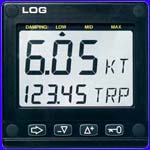Navigation and Chart work - The Vessel's Log Book or Log
The ship’s logbook
Of course, when you are navigating a vessel for real, you will need to work out what course the boat has steered and how far it has travelled.
This is why the Logbook is kept. In it you need to record
details of when  you passed buoys, what the log (the instrument
which records the distance travelled through the water) read at that
point, any changes of course and what courses were actually
steered.
you passed buoys, what the log (the instrument
which records the distance travelled through the water) read at that
point, any changes of course and what courses were actually
steered.
We normally also record weather information, wind force and direction, and the barometer reading. This information can be invaluable when you need to interpret the weather forecast.
There are many types of logbook available, the type I prefer is a hard back A4 sized book with lined pages, I then draw in the columns where I need them and put in my own headings. I always find that I do not use most of the spaces left in the ready made up log books that you can buy, but everyone develops their own preferences.
All these factors will vary in accuracy; no one can steer a boat in a straight line, a very good helmsman will vary at least 5 degrees either side of the required course. Instead of writing the requested course in the logbook, the best navigators estimate what the course actually steered was. One way of doing this is to encourage the helmsman to be honest in what they have really steered, there is no problem if the boat has been steered 10° off the requested course, as long as the navigator knows!
In addition, the log instrument may not be accurate. Logs need to
be  calibrated to the boat, and this will change as weed grows on
the hull during the season. You need to get in the habit of calibrating your log at regular intervals, the manual for your equipment will explain how to do this.
calibrated to the boat, and this will change as weed grows on
the hull during the season. You need to get in the habit of calibrating your log at regular intervals, the manual for your equipment will explain how to do this.
You can see why an EP has lots of possible errors built in, so always treat them like any navigational system, with caution. A prudent navigator always backs up the navigation by cross checking it with something else! (The depth at the time of plotting the EP is a good check).
On a longer voyage, the logbook should be written up at least every hour and at any changes of course. If the logbook is not kept up dated and you need to call for assistance you may not have the necessary information to hand to pinpoint your position.
Below is an extract from a yacht's logbook.
| TIME | COMMENTS | COURSE | LOG | WIND | BAR |
| 0900 | N.HURLESTON BUOY | 000°M | 10.4M | W4 | 1030 |
| 1000 | 000°M | 15.4M | W4 | 1029 | |
| 1100 | ALTERED COURSE TO 345°M | 000°M | 19.3M | W5 | 1028 |
| 1130 | ALTERED COURSE TO 355°M | 345°M | 22.6M | W4 | 1028 |
There is a specific way of filling out a logbook that is not obvious.
The entries mean that at 0900 the vessel was at the North Hurleston Buoy, steering 000°M. It followed that course until 1100, when it altered course to 345°M. This was not recorded in the COURSE column, because that is for what the boat has steered before 1100!
The new course appears at 1130, because between 1100 and 1130 the boat steered 345°M. Often you will enter in the log book that you have changed course to 345°M in the COMMENTS section, but later when you ask the helmsman what they have steered, they have not been able hold the vessel on that course and have perhaps steered 350°M instead.
Between 09.00 and 10.00 the vessel travelled 5M through the water.
This is the normal layout for the logbook.
Question 1
Chart 3. Variation = 7°W.
| Time | Comments | Course | Log | Wind |
| 0900 | At Colville E.Entrance OcR. Light to Starboard of vessel. |
Pilotage | 0.5M | N3 |
| 1000 | EP plotted. | 020°M | 7.0 | N3 |
A. If the tide was 106°T 3.5Kn. What is the EP at 1000?
B. What was the ground track in degrees true?
C. What was the distance made good?
Additional Resources:

